Prewar Early Vintage Elektoy 1 Gauge Toy Train Brass Loco Tender 4 Cars 10 track
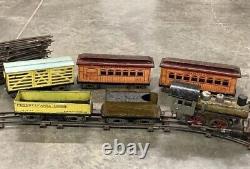
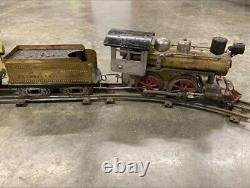
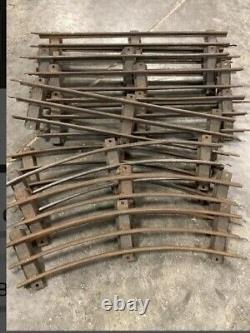
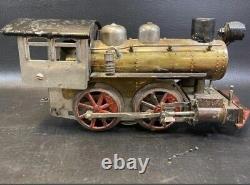
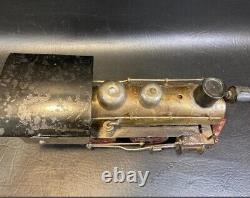
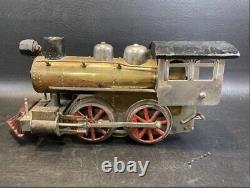

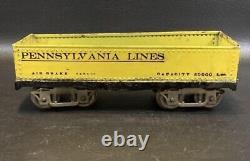
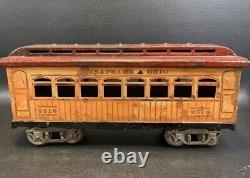
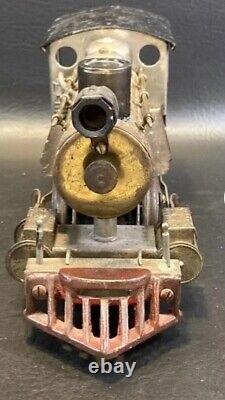
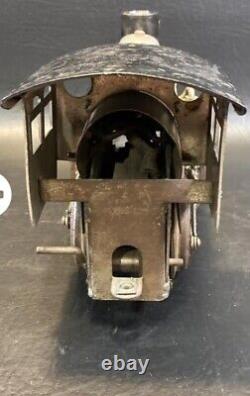
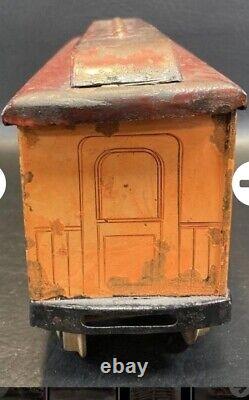


Prewar Early Vintage Elektoy 1 Gauge Toy Train Brass Loco + Tender + 4 Cars 10 pieces of track. I do not know much about these trains. Please use the pictures as part of the description and ask any questions you may have.
What you see is exactly what you get. The Elektoy train line was a #1 gauge series of tinplate manufactured in a small factory in Harrison, New Jersey, during a brief time period in the early 1900's, and has become a highly sought after and collectible commodity. The trains were produced in limited runs and since there are only two years of known cataloguing, and no advertising on a national basis was ever performed, there is not a great deal of information available on this company. The Hoops family (a father-son combination) initially operated the firm as Metal Specialties from 1875 to 1910, making various metal goods with a wide variety of uses. In 1910 the name Elektoy Train Line was patented. Shortly before any trains were produced, ownership passed to the J. Elektoy catalogs have been found for the years 1912 and 1913 but no other paper trail is known to exist. Elektoy #1 gauge New York Phila Balto Washington Passenger Set with #905 0-4-0 Steam Outline loco, 8-wheel tender, 2 #913 Coaches, #914 Combo car, made 1010-17. Elektoy made #1 gauge, three rail, all electric trains with the intention to compete in the middle of the toy train market. At the time, the lower end of the market was primarily'O' gauge trains made by Ives and German imports.The upper end of the market included Ives, Märklin and Bing #1 gauge and Lionel's Standard gauge trains. #1 gauge is 1 ¾ inches (1.75 inches or 44.45 mm) between the outside rail heads, making it larger than'O' gauge but slightly smaller than wide (Standard) gauge. It is also often referenced as being 1? Inches between the outside rails. The scale for #1 gauge is typically?
In those days, train sizes were defined using gauge, rather than scale. The four primary gauges having standards adopted were #0 (commonly called'O' gauge today), #1, #2 and #3. Elektoy #904 Black Center cab Electric outline Loco in #1 gaugeElektoy only created 0-4-0 type locomotives in electric and steam outline. The Elektoy line was characterized by very low prices. It was hand painted in maroon, gray and black. Livery was for the PRR, and the cab was numbered #9. It was modeled after the S-1 Electric prototypes that ran on the New York Central RR during this era. The nickel plated cab featured sliding doors.The 1912 catalog stated that the illuminated headlight could be "turned on and off simply by unscrewing the lamp a half turn, or vice-versa". The lettered numbers on Elektoy locos and cars did not correspond to actual catalog numbers. Elektoy #905 0-4-0 Brass Engine and tender in #1 gaugeElektoy steam type locomotives (#903 & #905) were made entirely of metal and included a bell, an octagonal headlight with pedestal, rivet detail on the steamchest, boiler and bunker. The Elektoy name is engraved on the steam chest.
The steam type loco bodies were removable without requiring the use of any tools. This was accomplished by unscrewing the locomotive's smokestack, then the boiler could be swiveled back on a hinge located under the cab.We are human, but we do our best to point out any flaws, etc. We will point out anynoticed flaws in description, but please check pictures carefully. Items are often from estates, so they may need cleaning, dusting, etc.
We are a pet friendly home and non-smoking. However, please remember lots of these items are rescued from estate or rummage sales, so we can't guarantee what environment they previously lived in. Due to the many variations in monitors, browsers, phones, lighting, etc, colors may appear different on different devices.
Devices are not all calibrated equally and color reproduction on the internet is not precise, so a color may appear a bit differently than how it appears online and in person. I have made my best effort to correctly identify and or describe the color. If you have any questions, please feel free to ask!!
If you love the item, but not the price, send us an offer. UGLY PACKAGING WARNING: We love our planet and trees. That's why we reuse packing material whenever possible.
Don't be alarmed if your item arrives in a reused box or padded envelope. We're trying to do our part! Please take a look at our other interesting, unique, vintage, and antique items for sale. Thanks for shopping with us! Track Page Views WithAuctiva's Counter. This item is in the category "Toys & Hobbies\Model Railroads & Trains\Railroads & Trains\Locomotives".tre" and is located in this country: US. This item can be shipped to United States, Canada, United Kingdom, Australia, Japan, South Korea, Indonesia, South Africa, Hong Kong, Bahamas, Israel, Mexico, New Zealand, Singapore, Switzerland, Norway, Saudi Arabia, United Arab Emirates, Qatar, Bahrain, Malaysia, Chile, Colombia, Panama, Jamaica, Barbados, Bangladesh, Bermuda, Brunei Darussalam, Bolivia, Egypt, French Guiana, Guernsey, Gibraltar, Guadeloupe, Iceland, Jersey, Jordan, Cambodia, Cayman Islands, Liechtenstein, Sri Lanka, Monaco, Macau, Martinique, Maldives, Nicaragua, Oman, Pakistan, Paraguay, Reunion, China.- State of Assembly: Ready to Go/Pre-built
- Color: Bare Metal
- Material: Metal
- Scale: 1 Gauge
- MPN: 01
- Year Manufactured: 1913
- Modified Item: No
- Power Supply: AC
- Gauge: 1
- Vintage: Yes
- Brand: Elektoy
- Type: Track
- Control: Analog
- Year: 1913
- Features: Tender, 3 Rail
- Recommended Age Range: 5-100
- Time Period Manufactured: 1900-1919
- Country/Region of Manufacture: United States
- Grading: C-4 Fair
- Vintage (Y/N): Yes










